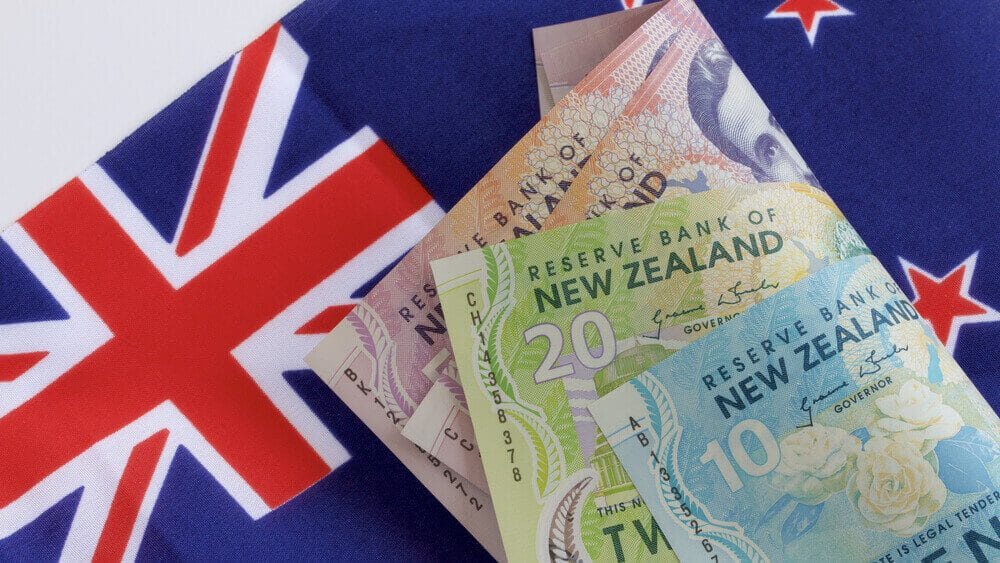Introducing NZDJPY
The NZDJPY currency pair comprises of the NZD or the New Zealand Dollar, and the JPY or the Japanese Yen. These are the currencies of New Zealand and Japan respectively. The New Zealand Dollar is the tenth most traded currency while the Japanese Yen is the fourth most traded currency. Together, the NZDJPY currency pair is the ninth most traded currency pair in the world. It is a minor currency pair due to having a low trading volume. It is a cross-currency pair due to not containing the USD. It is because it is a cross-currency pair that it is a minor currency pair as well. These two features come hand in hand. In order to properly understand how the NZDJPY pair works, we need to get some of our historical facts straight on their individual halves, the NZD and JPY. Let’s dive into it below:
The New Zealand Dollar
The New Zealand Dollar, abbreviated as NZD, was introduced in 1967. It is the world’s tenth most popular currency. Previously, New Zealand used the New Zealand Pound as its currency. Until 1985, the New Zealand Dollar had a fixed exchange rate with the United States Dollar. They were only permitted to utilize their own floating rates after 1985.
Their physical notes have undergone various revisions throughout the years to be visually appealing while also being more secure. New Zealand changed the composition of its notes from paper to polymer and plastic in 1999. This was done to make it much easier to detect counterfeit notes. This also renders the notes waterproof and more difficult to break apart. The printing on their notes is well-known for being extremely bright, and they are always upgrading the pattern to make it more appealing.
The Japanese Yen
The Japanese Yen is the national currency of Japan, the country of the rising sun. It is the world’s fourth most popular currency in terms of the trading volume. It is also Asia’s most extensively used currency. Since 1871, the Japanese Yen has been in use. As a result, it is one of the world’s oldest currencies. Japan relied on Spanish dollars prior to the creation of the JPY.
They didn’t start producing their own money until the Meiji government seized over. JPY currency notes are issued by the Bank of Japan. It’s also worth mentioning that the yen is one of the least expensive currencies in the region. In order to compete with foreign exporters, the Japanese government has tried to maintain these low rates by keeping its own export rates low. However, due to Japan’s economy’s rapid growth in value, this is becoming increasingly difficult.
Why Trade NZDJPY
The NZDJPY currency pair is fortunate to be pretty unique as it belongs to two regions that are totally different from one another. This provides more room to grow when they are placed together as a currency pair. Following are the top reasons to trade NZDJPY:
Interest Yields
New Zealand is well-known for its central bank’s high interest rates. These high interest rates are considerably higher than those of market giants such as the United States, the United Kingdom, and Australia. Traders are drawn to the NZDJPY currency pair due to its high interest yields as a result of these high interest rates. It has high interest yields as Japan has one of the lowest interest rates in the market. This pair provides significant yields due to the large disparity in interest rates between them. Because of the large payouts, traders frequently utilize a carry trade when trading this currency pair. Carry trade is the practice of selling a currency with a low interest rate in order to purchase one with a higher interest rate.
Market Predictability
The NZDJPY market conditions are rather easy to predict. This is due to the fact that changes in their respective countries, the United Kingdom and New Zealand, have the greatest impact on them. Because the USD is the standard currency for international transactions, any changes anywhere in the world would have an impact on a pair including the USD. Similarly, changes in any of the European Union’s 28 member countries would have an impact on a pair that contains the Euro. As a result, keeping track of every location that might have an impact on a currency pair becomes rather difficult. Currency pairs that are simply tied to a certain region, such as NZDJPY, are much easier to analyze since we just need to assess their individual countries.
Rate Volatility
The NZD/JPY pair might see some of the most volatile market situations in the forex space. This is a result of a variety of factors. The most important reason is that it has a large pip value. As a result, it is extremely sensitive to traders seeking to benefit from huge market changes. The second reason for this pair’s volatility is its low trading volume, which makes it less liquid. It has a limited trading volume since it is seen as a minor currency that is unrelated to the USD. A less liquid currency pair is more prone to market volatility since even slight changes in economic circumstances cause their rates to fluctuate rapidly.
NZDJPY Trading Tips
Since the NZDJPY is a minor currency pair that also has high interest yields and belongs to countries that are in completely different regions, it needs some strategies that are suitable for its situation. Following are top trading tips for the NZDJPY currency pair:
Trade Timings
Although the NZDJPY markets are open for trading at all hours, this does not always imply that it should be traded at all times. Each currency pair has specific times of the day when it endures the highest volatility and market fluctuations. The NZDJPY currency pair is the most active during the Asian trading session. This is because both New Zealand and Japan are active during this period. Therefore, you should trade this currency pair between 10 pm to 6 am GMT.
Carry Trading
One of the most common trading methods for the NZDJPY currency pair is carry trading. This is due to the fact that the New Zealand Dollar has a far higher interest rate than the Japanese Yen. Because of these interest rate variations, this currency pair has a massive interest yield. Carry trading is the practice of selling one asset at a lower interest rate in order to purchase another at a higher interest rate. It is crucial to note that, while this technique is ideal for this strong pair, it is still a high-risk strategy that should be executed with great care.
Trend Trading
Identifying patterns on trading charts and utilizing them to make trades is what trend trading is all about. Identifying an uptrend and a downturn are two of the most prevalent patterns that traders watch for. These indicate bullish and bearish market situations, respectively. An uptrend occurs when the highs and lows both rise. Similarly, a downtrend occurs when the lows and highs both fall. You can spot trend patterns simply by glancing at a chart, thus this is a relatively basic trading method that anybody can comprehend. Because the NZDJPY is known for exhibiting extended upward and downward trends, this is an excellent approach for this currency pair.
Factors Affecting NZDJPY
Both New Zealand and Japan are impacted by different factors and have correlations to different markets. When placed together as a currency pair, all these factors and correlations combine to form a pair that is extremely volatile when impacted by any of these conditions. Following are the top factors impacting NZDJPY:
Tourism Industry
To grow economically, New Zealand is heavily reliant on its tourist sector. They’ve lately been named one of the world’s top tourism spots. This is mostly owing to the excellent tour packages and other amenities that they provide. The greater the number of visitors that visit New Zealand each year, the better the NZDPYJ will do. Similarly, if New Zealand has weak tourism seasons, the NZDJPY will suffer as well. This was seen during the COVID-19 pandemic when New Zealand’s borders were closed because to health and safety concerns. It had caused a significant decline in the tourism industry, which had a negative impact on this major pair.
Natural Disasters
The earthquake emergency in Japan has had a big influence on the NZDJPY currency pair’s movement. Earthquakes and other natural disasters are very dangerous in Japan. This is because Japan experiences them more often than any other country. This is related to their physical location on Earth. As a result, Japan has had to improvise and design their country and infrastructure in a way to make it resist the pressure and damage that usually comes with earthquakes. This is because, when there is an earthquake, their economy suffers as a result of several areas that need to be repaired or rebuilt. They incur losses in the millions of dollars every time there is an earthquake. As a result, if the Japan Meteorological Agency detects an earthquake, the JPY depreciates, leading the NZDJPY to appreciate. Similarly, if the agency states that there will be no earthquakes in the near future, the value of JPY increases, leading the value of NZDJPY to decline.
Financial Institutions
Both the Reserve Bank of New Zealand and the Bank of Japan are majorly responsible for any instability in the NZDJPY marketplace. The RBNZ and BOJ release monthly reports and statements regarding updates to any policy changes. These reports also display the economic and monetary forecasts for the upcoming short-term.
Any positive results from the RBNZ will have a positive impact on the NZDJPY currency pair. However, any positive results from the BOJ will have an inverse impact on the NZDJPY currency pair. The representatives of these individual banks also hold speeches frequently where they explain these results in more detail. These speeches are just, if not more, important in determining the direction of the NZDJPY market. From RBNZ, Adrian Orr who is the Governor of the institution is highly looked upon for his speeches. From BOJ Haruhiko Kuroda who is the Governor of the institution is highly looked upon for his speeches.
Dairy Industry
Any changes in the dairy industry will have quite a significant influence on the NZDJPY currency pair. This is because New Zealand is the world’s largest exporter of whole milk powder. Their economy is heavily reliant on demand for this commodity. If the desire for this product rises, the NZDJPY will profit considerably.
Similarly, if demand for this commodity falls, the NZDJPY falls in value as their economy suffers. We may also look at it from a monetary standpoint. A rise in the price of certain sorts of dairy products would boost the value of NZDJPY, while a decline in price would lead NZDJPY to fall in value.
Crude Oil Industry
Over time, Japan has developed to become the world’s third-largest supplier of crude oil and natural gas. Their economy is heavily reliant on global demand for these items. Any changes in crude oil demand will have an influence on Japan’s economic value.
If global demand for crude oil rises, Japan will export it more frequently, causing the JPY to appreciate in value. This would result in a reduction in the value of the NZDJPY. Similarly, if demand for crude oil is lower than normal, Japan will be unable to export as much, causing the JPY to decline in value. As a result, the NZDJPY’s value would rise.
Gold Industry
New Zealand is a major exporter of precious metals such as gold and silver. As a result, its economy is heavily reliant on the export of these commodities in order to flourish and grow in value. Any changes in the market for these commodities, such as changes in demand or pricing, will have an immediate influence on the NZDJPY pair.
If the demand for gold rises, New Zealand will export more gold, causing the NZDJPY to rise in value. If the demand for gold falls, New Zealand would suffer since it will be unable to export as much of it, causing the NZDJPY to fall in value. This may be seen during wedding seasons in Asian countries, as demand for gold soars, causing the NZDJPY to appreciate in value.
Technology Industry
Japan is one of the world’s biggest technology exporters. They are also the leading producer in the sector. As a result, any shift in demand for technology products will have an immediate impact on the Japanese economy and, by extension, the NZDJPY. If worldwide demand for technology increases, Japan will export more than usual, leading the JPY to rise in value. As a result, the NZDJPY would lose value. Similarly, if demand for technological products falls, the JPY falls in value, leading the NZDJPY to rise in value. As a result, keeping an eye on this area is essential for an effective day of NZDJPY trading.
Most common questions asked by the forex traders about NZDJPY:
Forex GDP, Babypips, Tradingview, Forexfactory.
NZDJPY Trading Signals
Check Full Forex Market Signals with Technical Analysis Chart
Please note : It is better to do nothing instead of taking wrong trades, we focus on providing you the forex signals only at good trade setup.
Each trade signal given to you with fundamental and technical analysis chart which helps you to understand why our analyst team has given the Buy signals and Sell Signals. Now, you can trade with confident using our service. Sounds good? Let’s look out all our signal charts below.
If you want to test our forex signals, Try free plan (or) if you need more forex signals, Join here for Premium or Supreme plan
Check all our signal results and some of the subscriber’s Myfxbook results here. Try our free service now, let the results speak the rest.






